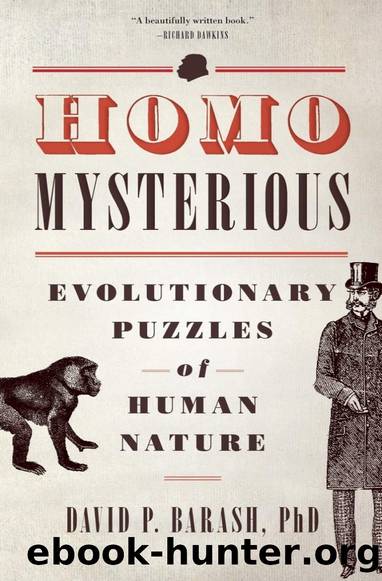Homo-Mysterious: Evolutionary Puzzles of Human Nature by David P. Barash

Author:David P. Barash [Barash, David P.]
Language: eng
Format: epub
ISBN: 9780199751945
Google: eGnf26i1jm8C
Barnesnoble:
Published: 0101-01-01T00:00:00+00:00
Chapter Six
~
Art II: Play, Practice, and
Sex (Again)
Perhaps art evolved because it provided an adaptive payoff via learning, something that benefi ted individuals regardless of its impact on the larger social group. After all, the arts offer abundant opportunities for instruction. John Dryden maintained that theater in particular offers âa just and lively image of human nature, representing its passions and humours, and the changes of fortune to which it is subject, for the delight and instruction of mankind.â Revisiting our earlier and perhaps overly negative discussion of art as providing vicarious, pornography-like opportunities for âcheap thrills,â maybe the emphasis should be less on the arts as procurer of subjective pleasures and more on how they provide palatable opportunities for adaptive information gathering, whether boring or dangerous or in between.
Learning and Play
Art â particularly literature â can be useful in providing not just
âteachable moments,â but also âteachable narratives,â stories that have genuine substance while offering prolonged connection as
we work our way through them. Such instructive narratives arenât necessarily as simplistic and iconic as âWhat might happen if I kill my father and marry my mother?â or âWhat are my options if Uncle Claude kills Dad and then marries Mom?â Rather, things can be at least somewhat more subtle: how to navigate a boring marriage to an even more boring country doctor, and what is likely to transpire if you have an affair? Beyond narratives of personal drama or historical scope (such as Napoleonâs invasion of Russia), imaginative stories â especially if they are not too imaginative, that is, if they retain the key quality of believability â can provide lessons that help us navigate the ordinary daily dramas that constitute a normal life.
Nor is the potential payoff of art limited to learning about our personal lives; it might help us explore the real world more generally. âArt opens up new dimensions of possibility space,â according to Bryan Boyd, âand populates it with imaginative particulars.â
Or, as Lewis Mumford once suggested, âIf man had not encountered dragons and hippogriffs in dreams, he might not have conceived of atoms.â Maybe so, but isnât it equally likely that we have often been misled by our imagination, deluded into believing in dragons and hippogriffs, along with ogres, saints, demons, dragons, gods, gremlins, trolls, and fairies? When dealing with the real world, which is notably intransigent, a case can be made that the human imagination needs not so much wings as lead weights. We must be anchored in reality, if only because when it comes to the harsh truths of evolutionary success or failure, thatâs precisely where we fi nd ourselves.
This, in turn, makes it all the more puzzling that when it comes to literature and its verbal companion, storytelling, people across the globe prefer fi ction to nonfi ction. One might expect, by contrast, that people would react with disdain and disgust to stories that are known to be untrue! After all, we have little use for dull knives, unpalatable food, ships that donât fl oat, or houses that fall down â that is, things that donât meet the stern tests presented by reality.
Download
This site does not store any files on its server. We only index and link to content provided by other sites. Please contact the content providers to delete copyright contents if any and email us, we'll remove relevant links or contents immediately.
Born to Run: by Christopher McDougall(7065)
The Leavers by Lisa Ko(6912)
iGen by Jean M. Twenge(5367)
Sapiens by Yuval Noah Harari(5294)
The Kite Runner by Khaled Hosseini(5085)
Spare by Prince Harry The Duke of Sussex(5074)
Machine Learning at Scale with H2O by Gregory Keys | David Whiting(4190)
Bullshit Jobs by David Graeber(4100)
Never by Ken Follett(3796)
Goodbye Paradise(3729)
Livewired by David Eagleman(3685)
Fairy Tale by Stephen King(3220)
A Dictionary of Sociology by Unknown(3031)
Harry Potter 4 - Harry Potter and The Goblet of Fire by J.K.Rowling(2990)
The Social Psychology of Inequality by Unknown(2941)
The Club by A.L. Brooks(2862)
Will by Will Smith(2794)
0041152001443424520 .pdf by Unknown(2785)
People of the Earth: An Introduction to World Prehistory by Dr. Brian Fagan & Nadia Durrani(2702)
